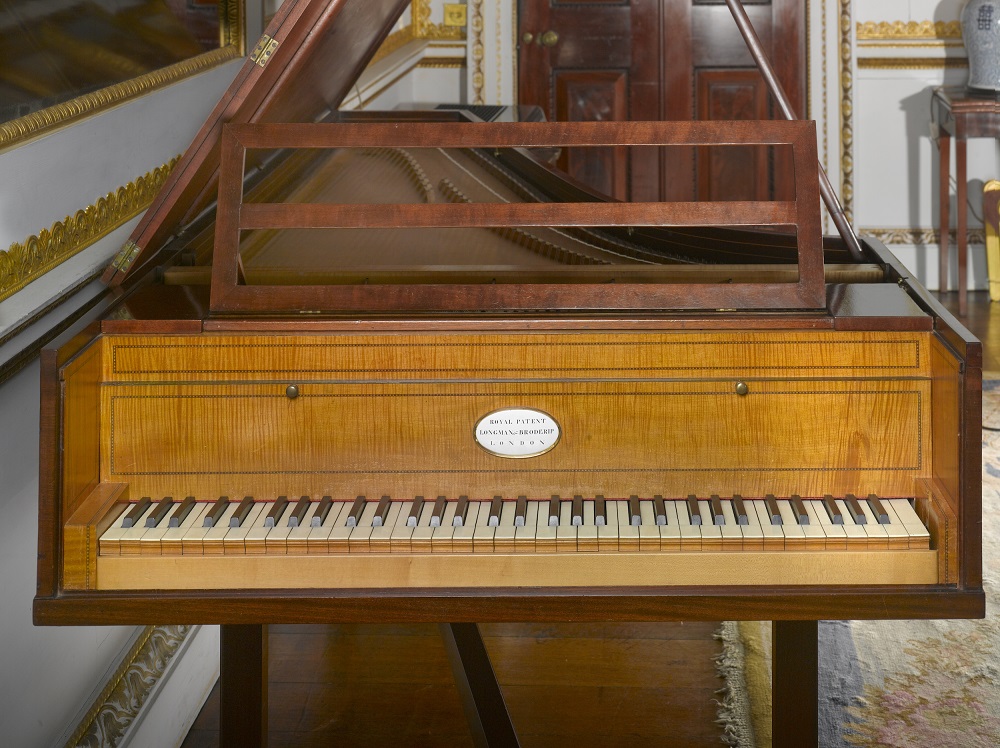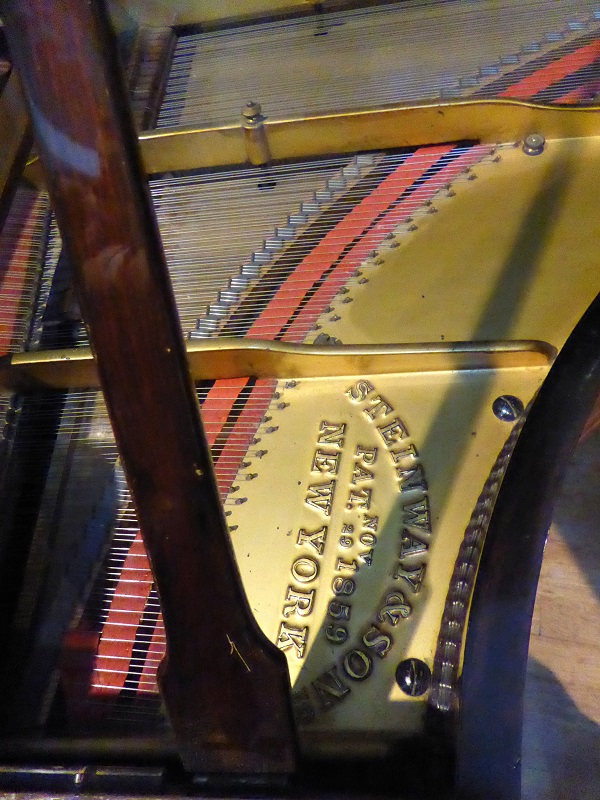Roman Rabinovich, Hatchlands review - poetry from Chopin's very own Pleyel piano | reviews, news & interviews
Roman Rabinovich, Hatchlands review - poetry from Chopin's very own Pleyel piano
Roman Rabinovich, Hatchlands review - poetry from Chopin's very own Pleyel piano
Transcendent Haydn, Chopin and Rachmaninov on three remarkable instruments
What pianist wouldn't long to lay fingers on keyboards impregnated, as Roman Rabinovich put it in his introduction yesterday afternoon, with the DNAs of Haydn and Chopin?
Maybe it would have been less impressive if the instruments weren't in such superb nick. Alec Cobbe, who assembled the collection and who as occupant from 1985 has transformed what was an empty shell when the National Trust took it over, has charitable support from Donald and Jeanne Kahn to keep everything in perfect working order. First up was the Longman & Broderip five-and-a-half-octave grand of 1794-5 (pictured below), previously owned by Haydn/Mozart scholar supreme H C Robbins Landon, coming with a very strong case of being the instrument Haydn took back to Vienna from London. As Rabinovich later pointed out, Haydn lived through changes to the keyboard as radical as the advent of the internet. He wrought a rainbow of sounds from it in Haydn's G major Sonata, Hob. XVI: 39: alongside the expected spring and perfect trilling, with re-fingering having been worked out to counter keys narrower than we're used to on modern instruments, it was startling to hear a welter of what came across as janissary-band wildness in the first-movement development - there are, incidentally, drum, bell and cymbal facilities in King George IV's Streicher grand of 1823 in the collection - and a rich, powerful bass in a rising line during the slow movement.
He wrought a rainbow of sounds from it in Haydn's G major Sonata, Hob. XVI: 39: alongside the expected spring and perfect trilling, with re-fingering having been worked out to counter keys narrower than we're used to on modern instruments, it was startling to hear a welter of what came across as janissary-band wildness in the first-movement development - there are, incidentally, drum, bell and cymbal facilities in King George IV's Streicher grand of 1823 in the collection - and a rich, powerful bass in a rising line during the slow movement.
The poetic wonder, though, was the one with the most potent personal connection - of three pianos associated with Chopin in the collection, the ineffable Pleyel he brought with him from Paris to London in 1848. He wrote: "in addition to my Pleyel, I have a Broadwood and an Erard, but I have so far only been able to play on my own one". Here was epiphany: to hear the unforced sounds Rabinovich wrought from it in three of the Ballades, harp-like in delicacy but with inward power during the torrents, you understood what was meant by transcendent Chopin. To hear it was to fall in love; I had a peculiar desire to take it home.

This end, too, was supremely eloquent, sadness so poetically overcome by the start of Chopin's Third, A flat Ballade and the further heart-leaping change to F major for the heavenly walking theme. If there was more disturbance in the final Ballade, it was transfigured again in the magical medium of that perfect Pleyel. Afterwards, we were lucky indeed to have brief demonstrations from the pianist of Mozart and Schubert on a Viennese grand and of Couperin on the most beautiful instrument to look at of them all, a 1636 harpsichord by the greatest of its makers, Andreas Ruckers. Return to Hatchlands for a special tour and you can hear sounds on J C Bach's and Marie Antoinette's pianos, and Mahler, Liszt, Bizet and Elgar on the instruments at which they composed. It's a paradise, and I've never encountered anything quite like it.
Postscript (16 October) When a pianist plays on three historic instruments, the living museum-pieces are likely to get the lion's share of the coverage. Hearing Rabinovich play the same works on the Wigmore Hall's Steinway Grand last night (★★★★★), plus his own Memory Box and the one Chopin Ballade missing from the Hatchlands recital, was to confirm that he is the colouristic genius as much as that gorgeous Pleyel Chopin loved so much. The biggest beneficiary was the Rachmaninov, the contemporary Steinway allowing a much wider tonal palette and all the more heartbreaking as a result. Rabinovich's suite highlighted the tonal variety and the full range of the keyboard; the Chopins extended that wavering between tragedy and optimism in the Corelli Variations. Even if uneasy tumutuousness wins out at the end of the Fourth Ballade, the first of the three encores - Rachmaninov's most exquisite miniature, the D major Prelude Op 23 No. 5 - brought perfect redemption. I've asked the pianist if he will write about the seminal experience of playing the same repertoire on pianos old and new, so watch this space.
rating
Explore topics
Share this article
The future of Arts Journalism
You can stop theartsdesk.com closing!
We urgently need financing to survive. Our fundraising drive has thus far raised £49,000 but we need to reach £100,000 or we will be forced to close. Please contribute here: https://gofund.me/c3f6033d
And if you can forward this information to anyone who might assist, we’d be grateful.

Subscribe to theartsdesk.com
Thank you for continuing to read our work on theartsdesk.com. For unlimited access to every article in its entirety, including our archive of more than 15,000 pieces, we're asking for £5 per month or £40 per year. We feel it's a very good deal, and hope you do too.
To take a subscription now simply click here.
And if you're looking for that extra gift for a friend or family member, why not treat them to a theartsdesk.com gift subscription?
more Classical music
 Bizet in 150th anniversary year: rich and rare French offerings from Palazzetto Bru Zane
Specialists in French romantic music unveil a treasure trove both live and on disc
Bizet in 150th anniversary year: rich and rare French offerings from Palazzetto Bru Zane
Specialists in French romantic music unveil a treasure trove both live and on disc
 Scottish Chamber Orchestra, Ibragimova, Queen’s Hall, Edinburgh review - rarities, novelties and drumrolls
A pity the SCO didn't pick a better showcase for a shining guest artist
Scottish Chamber Orchestra, Ibragimova, Queen’s Hall, Edinburgh review - rarities, novelties and drumrolls
A pity the SCO didn't pick a better showcase for a shining guest artist
 Kilsby, Parkes, Sinfonia of London, Wilson, Barbican review - string things zing and sing in expert hands
British masterpieces for strings plus other-worldly tenor and horn - and a muscular rarity
Kilsby, Parkes, Sinfonia of London, Wilson, Barbican review - string things zing and sing in expert hands
British masterpieces for strings plus other-worldly tenor and horn - and a muscular rarity
 From Historical to Hip-Hop, Classically Black Music Festival, Kings Place review - a cluster of impressive stars for the future
From quasi-Mozartian elegance to the gritty humour of a kitchen inspection
From Historical to Hip-Hop, Classically Black Music Festival, Kings Place review - a cluster of impressive stars for the future
From quasi-Mozartian elegance to the gritty humour of a kitchen inspection
 Shibe, LSO, Adès, Barbican review - gaudy and glorious new music alongside serene Sibelius
Adès’s passion makes persuasive case for the music he loves, both new and old
Shibe, LSO, Adès, Barbican review - gaudy and glorious new music alongside serene Sibelius
Adès’s passion makes persuasive case for the music he loves, both new and old
 Anja Mittermüller, Richard Fu, Wigmore Hall review - a glorious hall debut
The Austrian mezzo shines - at the age of 22
Anja Mittermüller, Richard Fu, Wigmore Hall review - a glorious hall debut
The Austrian mezzo shines - at the age of 22
 First Person: clarinettist Oliver Pashley on the new horizons of The Hermes Experiment's latest album
Compositions by members of this unusual quartet feature for the first time
First Person: clarinettist Oliver Pashley on the new horizons of The Hermes Experiment's latest album
Compositions by members of this unusual quartet feature for the first time
 Gesualdo Passione, Les Arts Florissants, Amala Dior Company, Barbican review - inspired collaboration excavates the music's humanity
At times it was like watching an anarchic religious procession
Gesualdo Passione, Les Arts Florissants, Amala Dior Company, Barbican review - inspired collaboration excavates the music's humanity
At times it was like watching an anarchic religious procession
 Classical CDs: Camels, concrete and cabaret
An influential American composer's 90th birthday box, plus British piano concertos and a father-and-son duo
Classical CDs: Camels, concrete and cabaret
An influential American composer's 90th birthday box, plus British piano concertos and a father-and-son duo
 Cockerham, Manchester Camerata, Sheen, Martin Harris Centre, Manchester review - re-enacting the dawn of modernism
Two UK premieres added to three miniatures from a seminal event of January 1914
Cockerham, Manchester Camerata, Sheen, Martin Harris Centre, Manchester review - re-enacting the dawn of modernism
Two UK premieres added to three miniatures from a seminal event of January 1914
 Kempf, Brno Philharmonic, Davies, Bridgewater Hall, Manchester review - European tradition meets American jazz
Bouncing Czechs enjoy their Gershwin and Brubeck alongside Janáček and Dvořák
Kempf, Brno Philharmonic, Davies, Bridgewater Hall, Manchester review - European tradition meets American jazz
Bouncing Czechs enjoy their Gershwin and Brubeck alongside Janáček and Dvořák
 Solomon, OAE, Butt, QEH review - daft Biblical whitewashing with great choruses
Even a top soprano and mezzo can’t make this Handel paean wholly convincing
Solomon, OAE, Butt, QEH review - daft Biblical whitewashing with great choruses
Even a top soprano and mezzo can’t make this Handel paean wholly convincing

Add comment